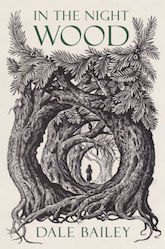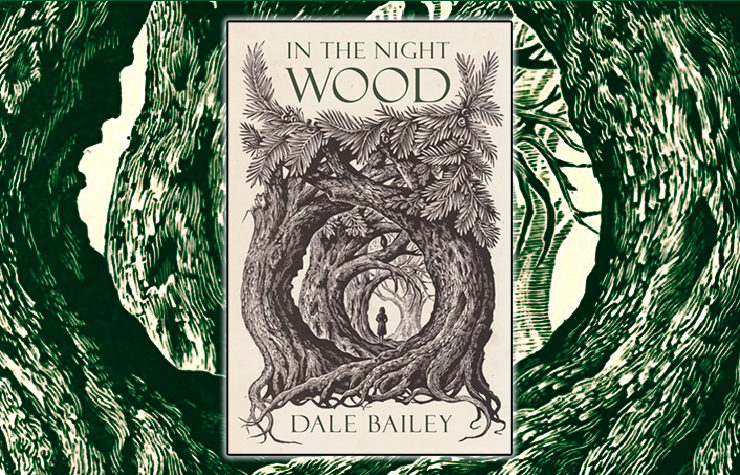There’s a point midway through Dale Bailey’s novel In the Night Wood wherein protagonist Charles Hayden ventures out to the forest around the English manor where he and his wife Erin have relocated following a tragedy on the other side of the Atlantic. In his exploration, Charles discovers a part of the forest that seems somewhat different from the rest: some of that can be chalked up to a sense of fundamental wrongness, and some of that can be be ascribed to a difference in temperature. But the sense of two places bordering one another, similar but with fundamentally different properties underlying their very nature, is a convenient metaphor for this novel as well, which is both a story about literary obsession and a story whose twists and turns may well lure in literary obsessives.
At the center of In the Night Wood is a fictional book, also titled In the Night Wood, and by a mid-19th century author with the magnificent name of Caedmon Hollow. When we first meet Charles, it’s as a young boy; he and his mother are at his grandfather’s house shortly after the older man’s death. Charles sees the book on a shelf and is drawn to it; as they depart, he impulsively takes it with him. While studying for a PhD, he goes in search of it in his school’s library; it’s there that he meets a woman named Erin, who turns out to be a descendant of Hollow’s. It’s serendipitous; it’s what could be a called “a meet cute.” Soon enough, Bailey tells us, they’ve married.
When next we see the Hayden family, it is far from a happy time for them. It’s years later. Erin has inherited Hollow’s old house; their marriage has become strained due to the death of their daughter and an ill-considered affair on Charles’s part. And so their relocation to England serves a number of purposes for them: a means to remove themselves from the site of their grief, a way to rekindle their marriage, and a means for Charles to pursue his research into the life of Caedmon Hollow, with an book—the first biography of this cult author—as the potential outcome.
From their arrival, though, things seem generally off. Erin’s penchant for processing her grief through visual art finds her inscribing sinister forms on paper, Charles senses odd presences around, and one of the manor’s staff isn’t acting himself. And there’s a perennial question of how much of Hollow’s menacing, dreamlike novel drew from the local folklore and how much was rooted in fact. The fact that the local pub shares a name—the Horned King—with a character in the novel within the novel seems to be more than an intriguing coincidence.
This is the sort of novel in which characters’ fixation on a fictional narrative proves all too real: Lev Grossman’s The Magicians and Jonathan Carroll’s The Land of Laughs are two relevant examples, and Bailey’s novel falls somewhere in between the two, tonally speaking. He also neatly balances the quotidian and the uncanny; for that, among other reasons, Pamela Dean’s Tam Lin and Kingsley Amis’s The Green Man would serve as two other worthy reference points.
Buy the Book


In the Night Wood
The exploration of local history and literature becomes a major thread in the novel. Charles meets a woman named Silva North, who runs the local historical society, and she winds up becoming one of the novel’s major characters, as her penchant for knowledge echoes Charles’s. That she’s mother to a daughter who resembles Charles and Erin’s lost child adds another wrinkle to the narrative—as does Charles’s fear that he’ll fall into another affair. Though, to Bailey’s credit, this is more about Charles’s anxieties than a genuine romantic spark between Charles and Silva—who seems more eager for a platonic and intellectual connection than anything.
Bailey’s novel is both a resonant tale of literary obsession and a story of old myths rising violently to the surface of an otherwise rational world. And it largely succeeds at both: its central characters are well-drawn, and its more uncanny aspects never overwhelm the emotional connections Bailey has established throughout the book. This isn’t to say that this book is without some frustrations, however. The handling of Erin’s depression is a particularly tricky aspect of In the Night Wood. It had the paradoxical effect of feeling emotionally correct but dramatically frustrating, leaving one of the novel’s most interesting characters on its margins rather than keeping her more central. Both Erin’s difficulty connecting with her surroundings and Erin and Charles failing to communicate at some crucial junctures felt emotionally true, but also occasionally too convenient for the plot.
Overall, however, Bailey has created an immersive setting, a fantastic sense of building tension, and a group of memorably flawed characters. In the Night Wood’s blend of literary history and sinister secrets was largely gripping throughout; it also left me in the position of many of Bailey’s characters: eager to be enchanted by the mysteries of both versions of In the Night Wood all over again.
In the Night Wood is available from John Joseph Adams.
Read an excerpt here.
 Tobias Carroll is the managing editor of Vol.1 Brooklyn. He is the author of the short story collection Transitory (Civil Coping Mechanisms) and the novel Reel (Rare Bird Books).
Tobias Carroll is the managing editor of Vol.1 Brooklyn. He is the author of the short story collection Transitory (Civil Coping Mechanisms) and the novel Reel (Rare Bird Books).










